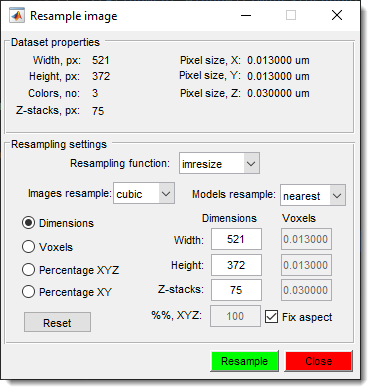Resample
Resample dataset
Back to MIB | User interface | Menu | Dataset
Overview
Resample the image and corresponding Selection, Mask, and Model layers to adjust voxel sizes or dataset dimensions.
Resampling can be done using:
- Dimensions mode
- Voxels mode
- Percentage XYZ mode
- Percentage XY mode
Select the resampling mode to define how the dataset is resized.
In mode, specify the
new width, height, and depth in pixels using
, ,
and fields.
In mode, enter the desired voxel sizes in physical units (e.g., micrometers) for each dataset dimension.
Choose the resampling function from the dropdown to determine the interpolation technique.
Select methods for images and models using and .
Click the button to apply the changes, or use the button to restore default settings.
Dimensions Mode
In mode, you define the new size of the dataset by entering the desired width, height, and depth in pixels:
- field: set the number of pixels along the X-axis.
- set the number of pixels along the Y-axis.
- set the number of pixels along the Z-axis.
This mode is ideal for adjusting the dataset to a specific resolution, such as reducing a large dataset for faster processing or matching another dataset’s dimensions.
The image and associated layers (Selection, Mask, Model) are resized to the specified pixel counts, maintaining the aspect ratio if X, Y, and Z are scaled proportionally.
Voxels Mode
In mode, you specify the desired voxel sizes in physical units (e.g., micrometers) to adjust the dataset’s spatial resolution:
- enter the voxel size along the X-axis.
- enter the voxel size along the Y-axis.
- enter the voxel size along the Z-axis.
This mode recalculates the dataset’s pixel dimensions based on the provided voxel sizes and the dataset’s physical dimensions. It’s useful for standardizing datasets to a common resolution (e.g., for multi-modal imaging) or correcting anisotropic voxel sizes.
The resampling process adjusts all layers to match the new voxel dimensions.
Info
The voxel size of the dataset are specified in Menu->Dataset->Parameters
Percentage XYZ Mode
In mode, you define a single scaling factor to resize all dimensions of the dataset:
enter a percentage (e.g., 50 for half size, 200 for double size).
All dimensions (width, height, depth) are scaled uniformly by this factor, affecting the image and all layers.
Info
This mode is convenient for quick resizing tasks, such as creating a lower-resolution preview or enlarging a dataset for detailed inspection, while preserving the dataset’s proportions.
Percentage XY Mode
In mode, you define a scaling factor that applies only to the XY dimensions, leaving the Z dimension unchanged:
enter XY percentage (e.g., 50 for half size, 200 for double size)..
Only the width (X) and height (Y) of the dataset are resized, making this mode suitable for adjusting in-plane resolution without altering the number of slices in a 3D stack.
It’s particularly useful for datasets with anisotropic voxels where Z-resolution differs significantly from XY, allowing targeted scaling of the image and layers.
Resampling Functions
The dropdown offers three MATLAB-based methods to compute the resampled dataset, each with specific interpolation options for images and models:
Uses MATLAB’s interpn function for n-dimensional interpolation, suitable for precise resampling of 3D and 4D datasets. It calculates new pixel values by interpolating between existing ones, supporting isotropic and anisotropic scaling.
- Image resample methods:
nearest: assigns the value of the nearest pixel (fast, blocky).linear: linear interpolation for smooth transitions (balanced speed and quality).spline: spline interpolation for higher smoothness (slower, high quality).cubic: cubic interpolation, similar to spline but slightly different curve fitting.
- Model resample methods: Same as image methods (
nearest,linear,spline,cubic), ensuring consistent resampling of segmented layers.
Employs MATLAB’s imresize
function, optimized for 2D image resizing but extended to 3D datasets slice-by-slice.
It’s faster for large datasets but less flexible for anisotropic scaling.
- Image resample methods:
nearest: Nearest-neighbor interpolation (fastest, least smooth).box: Box kernel averaging (simple, moderate quality).triangle: Triangular kernel (bilinear-like, balanced).cubic: Bicubic interpolation (smooth, high quality).lanczos2: Lanczos kernel with 2-lobe window (sharp, detailed).lanczos3: Lanczos kernel with 3-lobe window (sharpest, slowest).osc: Custom oscillation-based method (experimental, high quality).
- Model resample methods:
- Only
nearestis supported, as models require discrete values to preserve segmentation boundaries.
- Only
Utilizes MATLAB’s tformarray function for affine transformation-based resampling, ideal for complex scaling and alignment tasks.
It applies a transformation matrix to the entire dataset.
- Image resample methods:
nearest: Nearest-neighbor interpolation (fast, preserves edges).linear: Linear interpolation (smooth, moderate quality).cubic: Cubic interpolation (smoothest, computationally intensive).- Model resample methods:
- Same as image methods (
nearest,linear,cubic), allowing flexible resampling of model layers.
Select the desired method for images via and for models via to balance quality and performance based on your dataset’s needs.
Note
For large datasets, use nearest or imresize for faster processing, and test settings on a small region using the ROI panel before resampling the entire dataset.
Back to MIB | User interface | Menu | Dataset
